

49 Tips & Strategies for Successful UK Holiday Marketing Campaigns

It’s official: #FirstDayOfSchool2017 is trending on social media and the back-to-school shopping season is in full force. Summer is culturally over in the U.S. –– marking a shift in mindset for retailers across the globe.
As the “slow” season draws to a close and the busiest time of the year quickly approaches, there is one lingering question all brands must answer: are you ready for the holiday season?
For most, the answer is a resounding “not yet,” which means there is no better time than now to start thinking about your holiday marketing campaigns.
The season formally begins with Black Friday and Cyber Monday (also known as “Cyber Week”) and leads up to the slew of December holidays.
You don’t want to miss seasonal promotional opportunities or holiday shopping sales — especially to your competitors who may have started preparing already.
That said, we have now entered the planning phase –– arguably the most important part of a successful season.
Creativity is key in order to win mindshare. Yet, channel distribution is necessary in order to win sales. This is a balancing act between marketing and operations –– two retail departments continuing to better blend as consumer expectations demand seamless experiences.
Knowing this, we consulted with 49 of the top ecommerce marketers, agencies, consultants and brands in order to gauge how your teams should be allocating resources across departments and customer touch points for holiday marketing campaign planning. In speaking to these experts, 12 areas of concentration emerged. We’ve ordered them in priority based on the number of respondents that spoke to each need.
The following holiday marketing tips and promotion ideas will help you refine your efforts to ramp up sales during the most profitable time of the year.
Prepare for the Holidays Early (You’re Already Late!)
Bill Widmer, Ecommerce SEO & Content Marketing Consultant

Focus on SEO. Many keywords are seasonal, so if you’re ranking well for your main keywords, you’ll pick up on a ton of extra free traffic.
Social is great, but search is better.
And do it now. SEO takes time, so if you want to rank in December, you need to start today. Give it at least 6 months to see results; 12 to really see things kick in.
Of course, this process can be sped up significantly if you work with an SEO expert.
Rupert Cross, Digital Director, 5874

Plan, plan, plan – you should be working months ahead of the event. You should know well in advance when your last shipping days are and what your Black Friday offers or any other holiday deals are, so you should be working around these.
Develop your marketing strategy early, with pre-written emails and content, and this way you can edit later rather than start from scratch during your busiest time.
Chad White, Research Director, Litmus
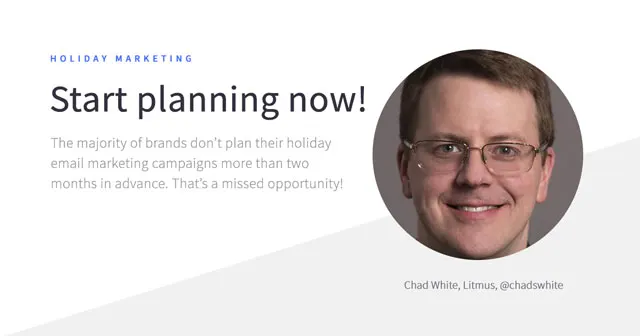
Start planning now! The majority of brands don’t plan their holiday email marketing campaigns more than two months in advance, according to our State of Email Production report. That’s a missed opportunity, given how much revenue is at stake and the additional production workload that occurs during the holiday season.
On average, retailers increase their email frequency to their subscribers by roughly 50% during November and December, compared to non-holiday months. That’s a lot of extra emails that have to get designed, coded and QAed. Starting early can help marketers avoid rushing later.
Paige Gerber, Head of Marketing, Vantage

Retailers can acquire up to 59% more customers during the holiday season. In 2016, Black Friday and Cyber Monday shifted from two days into an entire weekend of sales. We saw bigger discounts, longer sales periods, and an increase in shoppers and order sizes.
The best thing you can do as an ecommerce business is plan ahead. (21.26% of BigCommerce businesses start their holiday campaign planning in September, according to our recent study on holiday ecommerce plans.)
Make sure you have a holiday campaign strategy for both your online advertising and email marketing. These marketing channels are essential to increasing sales over the holidays. Social ads are a must! Get in front of shoppers where they already spend the majority of their time, and show them with a beautifully built ad why your product is a must-buy this holiday season.
Sweta Patel, Director of Demand Generation, Cognoa

I would say start early and engage your database before anyone else. Use ads that stand out and raise curiosity.
For example, with one Silicon Valley startup we used a rabbit with a pancake on its head to sell our latest marketing tool for CMOs. It was effective just because people didn’t know what we were selling and they found the ad to be funny.
It was actually our most engaged ad in the history of the company. Our conversions increased from .6% to nearly 20% after the holidays.
Jim Huffman, Marketing Consultant, Packlane

Plan 3 months in advance because it’s always crazier than you remember. Facebook and Instagram will be good, but oversaturated. Look at innovative ways to ride the news cycle with creative content and influencer marketing.
Suzanne Moore, Narrator, All About Suzy

Know your market and brand. For the crafting industry, promoting holiday stamps now is mandatory!
People are getting ready for craft shows during the summer and early fall months. Giving them inspiration and the supplies needed early is going to help them and your sales.
Post completed projects for inspiration on Instagram and Facebook to get maximum exposure. Use Facebook groups more so than your Facebook page to give your brand a more humanized feel. People want to buy from people, not from a “company.”
Interact, show off your new goodies, post pictures and videos showcasing the new products.
Annie Cushing, Founder of Annielytics

Start testing retargeting campaigns now, if you’re not running them already. Retargeting and email tend to be significant cash cows around the holidays.
Case in point: A couple years ago, I left a couple key gifts in the cart on one website but checked them off as bought. The next day, I had a retargeting ad letting me know I left two items in the cart.
That ad saved Christmas for one of my daughters!
Jamie Turner, CEO, 60 Second Marketer
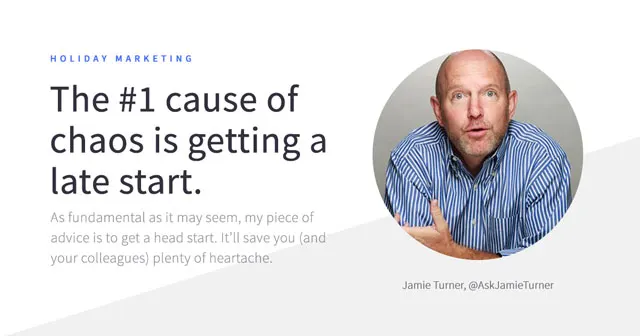
This advice is going to seem pretty fundamental and straightforward, but it can also save you tons of stress and can prevent needless mistakes.
As most marketers know, the #1 cause of chaos in preparing any campaign is when you get a late start. There’s nothing worse than trying to make a deadline under duress. It creates unnecessary stress and leads to mistakes that are easily avoidable.
So, as fundamental as it may seem, my piece of advice is to get a head start. It’ll save you (and your colleagues) plenty of heartache. And, since you’ll be ahead of the curve, you’ll have time to step back, take a look at what you’re doing, and then make tweaks and improvements before launching.
Getting a head start. Crazy, I know. But it works!
Jeff Sauer, Founder and Lead Instructor, Jeffalytics

My best advice for brands to execute a successful holiday marketing campaign is to start early! If you start your marketing plan in November, the holidays will be over before you have insights into performance or have the chance to optimize.
The sooner you can test messages, creative and email strategies, the sooner you can make the adjustments necessary to significantly improve your results. This involves being flexible, open to new ideas, and planning out actions that you will take when certain scenarios occur. Plan early. Plan often. Plan to succeed!
Jana Skulinova, Marketing Manager, MonkeyData

The one best piece of advice I can provide is to prepare well in advance.
Keep in mind that there will be even more day-to-day operations work during the holiday season, so it’s best to have everything marketing-related in place beforehand.
Here are the most important things you should be preparing before the holiday season.
Ensure you have the bandwidth for traffic spikes: Check the past performance of your website against seasonal spikes in traffic. Be sure that you have the bandwidth to handle this extra traffic and that your site performs well under the extra pressure. If your website is slow or crashes, you will lose customers (many of whom may have turned out to be returning customers). Keep your average page loading time under three seconds –– under two, if possible.
Make certain your inventory is ready: The holidays are the most important time to be paying attention to inventory forecasting. Develop a robust forecast of which products will sell at which time, and allow sufficient lead times to get your products in. Late-arriving products can cause other problems for your operations and create problems down the whole chain.
Bring on additional staff to handle increased orders: Calculate staff capacity and ensure that it can handle the worst-case scenario. This goes for handling orders (a very time-consuming process) as well as answering customer queries. Shipping orders quickly will keep those customers coming back. Aim to keep your average shipping time consistent during the holiday season. Also, answering those customer queries faster will lead to higher conversion rates. After all, it’s easy for customers to switch to a competitor during the frenzy of the holiday rush.
Email marketing: Do you have a list of buyers who might be ready to come back? Maybe they just haven’t thought about you for a while. The holiday season is the best time to hit them up again. This is a great opportunity to leverage your holiday promotions and of course, use great holiday-related content to entice people to shop.
Pay-per-click advertising: Although there will be a lot of competition from other retailers during the holiday season, this is a great opportunity to attract new buyers to your store, especially if you launch your campaigns early. Highlight your promotions and offers in order to attract buyers.
Richard Lazazzera, Founder, A Better Lemonade Stand
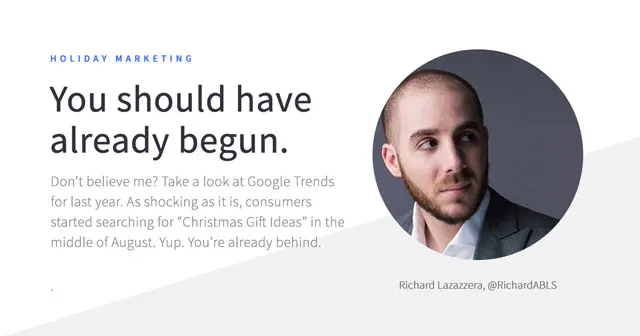
Being an entrepreneur and managing a million things means lots of tasks tend to fall through the cracks, and sometimes, even important things like holiday planning for your online store gets pushed to the back burner.
With the holiday season being on the the most lucrative time of the year for ecommerce, it’s something that deserves extra attention and preparation.
So when should you begin your holiday promotional planning?
It turns out, you should have already begun. Don’t believe me? Take a look at Google Trends for last year. As shocking as it is, consumers started searching for “Christmas Gift Ideas” in the middle of August. Yup. You’re already behind.
If you’re going to take full advantage of Q4 and all the holidays it has to offer your online business, you need to begin preparing and planning immediately.
The best way to get started is to map out a promotional calendar. Start by printing out a calendar of the last three months of the year, and reviewing all the holidays in that three month period that you want to participate in.
From there, work backwards to identify when promotional graphics need to be created, when email copy needs to be written, when those emails need to go out, etc.
Starting now and mapping important dates on a calendar can go a long way in helping you prepare, allowing you to take full advantage of the increased consumer spending habits of the holiday season.
Ryan BeMiller, Founder, Shopping Signals

My advice is to be prepared. Preparation for a holiday ecommerce marketing campaign should at least include the following activities:
Schedule your campaign activities: From creative, to technical, to launch, it’s critical that campaign activities are scheduled well in advance, with plenty of buffer room for the inevitable hurdles that you’ll face.
Make sure you’ll be adequately staffed: Increased activity means increased need for customer service and fulfillment staff. Make sure you’ll be ready. Customers don’t care that your order volume is the cause of slower response times. They expect the same level of service all year long. Consider adding live chat. This is a great way to address customer concerns and keep them moving down the funnel.
Give your site a festive, holiday feel: This tends to heighten the emotional shopping experience, which can boost conversions!
Feature your top sellers and offer gift suggestions.
Figure out your holiday shipping deadlines and plan to post them prominently: This is both helpful as well as adds a subtle bit of urgency, which is a conversion booster. Plus, it’ll mean fewer headaches on the fulfillment side.
Determine which channels to focus on: Will it be email, blog posts, Facebook ads, etc.? Get a clear picture of your channels so you can develop holiday marketing strategies for each, and perhaps an overall strategy that makes them all a cohesive unit.
Develop landing pages for specific products and promotions: These convert much better than a standard product detail page.
Track your results: Make sure you’re tracking individual campaigns and channels, as well as money in vs. money out.
Cash in on Exclusivity (And High ROAS)
David Tendrich, CEO & Co-Founder, Reliable PSD

During holidays, people are out looking for deals. Your best bet is to create a special “holiday deal” that’s too good for your market to pass up.
It *has* to pass the “you’d be crazy not to grab this deal” test. If it doesn’t give you or others that reaction – it’s not good enough.
That doesn’t mean crazy discount, by the way. It can mean adding in other services, products or deals to create a bundle.
Max DB, Founder, HeyMaxDB

Create an offer, ideally with an exclusive product only available during that time of the year.
Facebook is the biggest “instant” channel right now, and coupons and rebates work great on there.
Just make sure that you use landing pages for the offer, or optimize your whole site around that offer come the holidays.
Bill Bailey, CEO, Nodal Ninja

We sell to a niche market and find the wife is not likely to buy the husband photographic equipment as only the photographer knows best what he needs. So, what we’ll experiment with this year is offering up gift cards in advance of holidays but with an added twist.
For example: Buy a $75 gift card now. Use it from x date to x date and redeem for $100 in purchasing power. After holiday or x date it reverts back to face value.
We use social networking blasts, newsletters and Google Adwords. Google Adwords has always performed best.
Ed Lasher, Marketing Guy, Bob Johnson’s Computer Stuff, Inc.

Come November, folks have a lot more tolerance for promotional material.
Run a sale and let everyone know about it! Send a lot of emails and exhaust your social media channels.
It doesn’t matter if your products don’t make for good holiday gifts. We all know people use holiday sales to buy things for themselves.
Sell More Than Your Product –– Sell Your Brand
Daniel Wallock, Marketing Strategist, Wallock Media

If you’re planning on ramping up your sales during the holidays, you need to be available or have someone available to answer customer support questions and you need to be ready to respond to comments and other inquires on social media.
Just being responsive and available will help you convert the people who demonstrate interest into buyers.
Besides ramping up paid acquisition channels, I think the holidays are a perfect time to begin going out to your target audience with content and posting valuable information in niche communities.
Go to the places your audience is hanging out and offer value, but then also promote your product by offering their community a deal.
Engage directly with people on Twitter, Reddit, Facebook Groups, etc. and help them.
A ton of companies are spending money on advertising during the holidays. Another great avenue would be to use influencers to market your products instead of spending on paid ads.
Shayla Price, B2B Marketer

Sell the brand lifestyle, not just the product.
Every holiday season, millions of companies compete for a portion of the consumer’s wallet. Where most fail is continuing to sell based on price or the product itself.
If you want to drive sales this holiday season, position your products as a lifestyle choice.
This strategy empowers the consumer to be part of an ideal (e.g. luxury, fitness or adventure). By human nature, we want to join these types of lifestyles. Therefore, the consumer mindset changes. Instead of brooding the price, your consumers become eager to embrace a lifestyle as they select your product over the competition.
Get Up Close and Personal (It’s The Holidays After All!)
James Brown, Client Engagement Manager, RANDEM
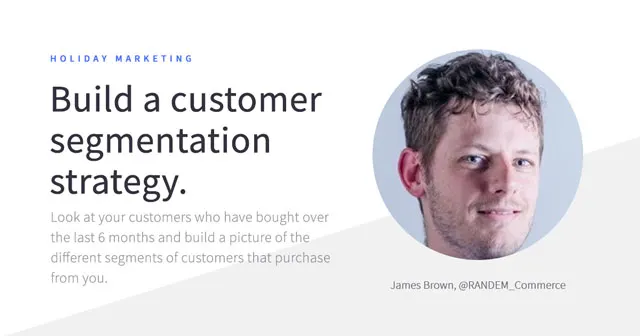
Typically, the most lucrative marketing activities an ecommerce business can do are those directed toward their existing audience and customer base. An effective way to increase the ROI of your marketing is to adapt and personalize the marketing messages and channels to what each of your customers are most likely to respond to.
The first step along this path is to start to build a core customer segmentation strategy.
Look at your customers who have bought over the last 6 months and build a picture of the different segments of customers that purchase from you.
These segments can be based on demographics (age, sex…) type of product bought (the main different types of product categories you stock) or even how much they’ve spent or how many times they’ve bought (watch for your big spenders!).
Try to limit the number of segments to around 5 (the goal is to keep the complexity low) and place each of your customers into a given segment. For some, this might be difficult, as they could fall into a number of them, but it’s important here for consistency that each customer lives only in one place.
Next, you’ll need to craft an effective marketing message, one per segment, that you think will resonate with the majority of customers in that segment.
This could be a promotion on equipment for a particular sport they’ve shown interest in if you’re a multi-sports store, for example, or an offer to become part of an exclusive loyalty club if they spend over a certain amount before the end of the year.
Once you’ve built your messages (and any promotions or otherwise that you need to support them in BigCommerce), you need to settle on the best channel or channels that will get the most traction for each segment.
Perhaps social for your younger audience, and email for the older ones, for example, and build out the strategy of which marketing campaigns you are going to run and when.
Finally, as with all marketing strategies, you must be sure to measure the effectiveness of your campaigns after the dust has settled, understand what worked and what didn’t, make the necessary changes to your customer segments and marketing messages, and prepare the whole thing again for the next holiday season!
Edin Sabanovic, senior CRO consultant, Objeqt

Create personas and establish how each of them navigates the website and what channels they use to get there.
Track how personas behave on holidays and adjust to their preferred channels with your ad messaging. When you have accurate personas, you can personalize the message and address their specific needs.
When you track personas and know what channels they use on holidays, you can double down on these channels to both increase the traffic and make visitors more likely to convert.
Donald Pettit, Sales & Partners Manager, SalesWarp

When it comes to marketing, personalization is key. Shoppers are bombarded with ads everywhere they look, whether it be their personal email inboxes or their social media accounts.
Break through typical content by using customer data and order history to create personalized ads. If customer order history shows that a customer purchased a surfboard three months ago, target them with ads promoting a holiday sale on surfboard accessories.
This ad is much more likely to get their attention rather than a generic surfing gear ad.
In terms of channels, don’t forget to take advantage of social channels such as Facebook and Instagram. Also, keep in mind that most customer’s research starts on Amazon, but do not overlook your Google shopping feed: lots of customers will continue to use that tool and it’s great for easily spreading your promotions.
Launch a Holiday Channel Strategy Now (Or Lose Out Later)
Daniel Clutterbuck, Ecommerce and Social Media Strategy Consultant

You’re looking to gain some reach and big exposure these holidays, right? Have you considered Instagram?
Startups and established brands utilize what are called “influencers” to promote their content to the masses. To make sure you get it right and don’t waste too much money, remember the following tips:
Understand your target demographic/persona
Research pages that your target persona may follow
Look at who has tagged your competitors by clicking the tag link on their Instagram page
Search on hashtags that describe your product e.g #reddress
When you find an influencer, scrutinize their engagement. People buy follows and likes these days, so a great way to spot a true influencer is by the amount of comments they have.
Get prices off them and negotiate! Never accept the first offer!
Campaigns work better when you pull back the trigger on a few, then BANG! Release them all at once within a 24-hour period. I call this a “Blitz Campaign” and they work ridiculously well.
Brands just like yours are running influencer campaigns across a multitude of pages on Instagram. They range from bloggers to what I call “sector pages” (for example, fashion, quotes, fitness). These aren’t people, they are brands in and of themselves. They charge the cheapest and you can reach a high number of people.
Think out of the box when you’re looking and if you want to ask me any questions, tweet me on @DCLUTT or check out my IG page (113k followers).
Ross Simmonds, Founder, Foundation Marketing

My #1 tip for brands looking to ramp up holiday marketing and increase sales over the holidays is to spend a bit more time looking at the channels your competition is ignoring.
Millions of people are visiting sites like Pinterest, Reddit, StackExchange, Quora and YouTube every single day, but many brands are only focused on Facebook, Google and some variation of Twitter/LinkedIn/Instagram.
Instead of following the crowd, create your own path by reverse engineering the success that others have had on niche channels and double down on them.
Kaleigh Moore, Freelance Writer

I think Instagram is a great discovery tool –– and there are lots of opportunities for better linking for direct sales rolling out here. I personally use Instagram all the time to discover new products, and I think others are, too.
The Time For Tests is Over – Double Down Where It Works
William Harris, Ecommerce Consultant, Elumynt

Focus on what you do best. If you’re great at FB ads – double down there. If you’re great at email marketing – that should be what you ramp up.
The holidays aren’t the time to test out new ideas as much as they are a time to double down on what you’ve been very successful with the rest of the year.
Timi Garai, Marketing Manager, Antavo Loyalty Management Software

Use those channels which drove the best results in the previous holiday season for you. But never forget to pay extra attention to email marketing and mobile.
According to last year’s Black Friday statistics, for the first time ever, more than $1.2 billion in revenue was generated in a single day through purchases made on mobile devices.
Holiday Selling on Amazon? What You Need to Know
Bryan Bowman, Owner, eCom Underground

For Amazon sellers, it’s Headline Ads and AMS…hands down. For off-Amazon traffic, we focus on developing our Facebook pixels and retargeting leading up to Q4.
James Thomson, President, PROSPER Show

If you sell on Amazon, be sure to get your FBA inventory to Amazon by November 10, at the latest.
If you expect to sell through most inventory, calculate the cost of a stockout vs. holding more inventory….usually better to have more inventory in FBA. And don’t forget to plan for inventory you expect to sell in January…so many companies run out of inventory in early January when suppliers are slow to replenish.
Make Customer Loyalty a KPI
Ryan Pfleger, Founder, PayWhirl

Get your promotions ready! Make sure that you have attractive deals if you use coupons or discounts and make sure they are easily accessible on other coupon websites.
You could also offer gift SUBSCRIPTIONS quite easily (the gift that keeps on giving, even after the holidays). With PayWhirl you can set up profiles (like Amazon) when you check out, so it’s easy to order a subscription for a friend, etc.
Steve Deckert, Co-Founder, Smile.io

Oftentimes when companies think about the holiday season, they get all caught up in the number of people that will be brought on by those couple months alone. However, the most important part of the holiday season is actually focusing on longevity and ensuring you retain those customers and give them a reason to come back.
There are a few ways you can do this, such as a customer rewards program, but you also have to make sure that you provide the best possible experience when customers land on your site.
Make sure that your site, your inventory and everything else are conducive to a fantastically smooth experience. When it comes to the holiday season, you must first look inwards before you reach outwards.
Raheem Sarcar, Founder and CEO, RewardCamp

The biggest mistake that retailers make when executing a holiday marketing campaign is lacking a nurturing system that converts new customers acquired from holiday promotions into repeat buyers.
There’s a very good chance that a customer who bought from you during a ‘back-to-school’ or Mother’s Day promotion will return and buy again. But they will return only if you have a nurturing system in place.
I’ve seen retailers increase repeat business by 300% as a result of converting new customers into repeat customers.
The good news is that it can take very little work to nurture new customers. One of the most effective ways to nurture customers is by implementing a customer-friendly loyalty app.
A good loyalty app will do two things very well:
It will make it easy for customers to earn rewards
It will nurture them into returning whenever they are ready to buy again.
With a good loyalty program in place, retailers can get a bigger bang from their holiday promotions.
Susannah Morris, Industries Marketing Specialist, Hubspot

To execute on a successful holiday marketing campaign, you need to think big picture. Too often brands get tunnel vision and only focus on short term customer acquisition over the holidays.
For you to have a truly successful holiday season, consider how you’re going to engage with holiday customers in the longer term and keep them coming back. Focus on customer lifetime value, instead of one-time customer acquisition.
Joel Cherrico, Founder, Cherrico Pottery

Our holiday sales grow every year because we experiment respectfully with our pricing strategy. We raise and lower prices on new mug styles. We use video and stunning photography to bring customers inside our studio by simply opening an email or checking out our Facebook page.
We remind customers of our massive accomplishments, like our pottery Guinness World Record. We give them amazing deals that sell out in a day or two. Our team does whatever we can to help customers understand that we are giving them remarkable deals on functional artwork that is truly world-class.
Mind Your Metrics (Or End Up in the Red)
Jason Boyce, Co-founder & CEO, Dazadi
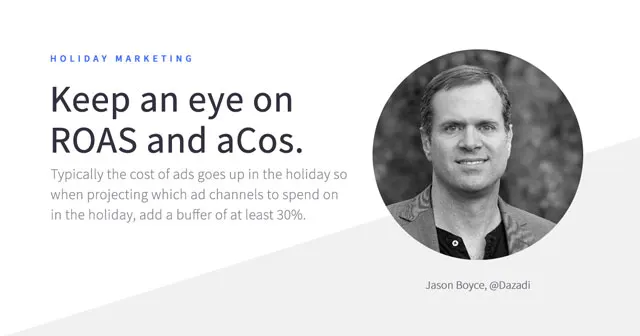
Keep an eye on ROAS and aCos. Holiday sales are great, but profitable holiday sales are better.
Typically the cost of ads goes up during the holidays, so when projecting which ad channels to spend on in the holiday, add a buffer of at least 30%.
On average our ad costs increase 30% during the holidays due to higher demand and activity, especially when the ad source price is bid on like PPC, etc.
Alex Birkett, Growth Marketer and Content Strategist, ConversionXL

Holiday campaigns are by nature short-term. So if you’re running a promotion and you decide to A/B test it (instead of just guessing what will work), then by the time the test is valid and the results are actionable, the holidays are over and the learnings are no longer ‘exploitable’ (meaning you can’t really extrapolate the learnings beyond that short time period).
So for holiday campaigns, and other short-term campaigns, try using bandit algorithms, or at least some other form of adaptive dynamic programing. Instead of running a controlled experiment in which traffic is divided equally over the course of the test and then everything is allocated to the winner at the end, bandits work in real time to shift traffic towards the winning variation.
People refer to this as “earning while you learn.” You can easily set up bandit tests using a tool like Conductrics.
Harrison Dromgoole, Content Creator, Ordoro
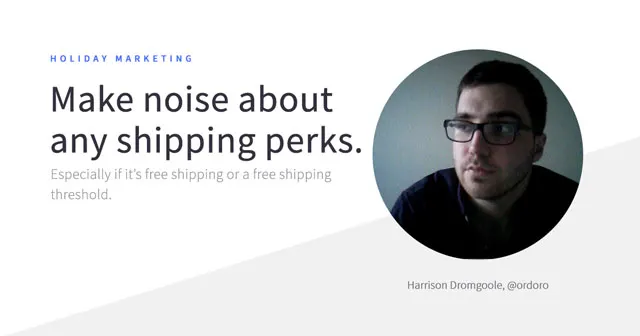
Shipping, shipping, shipping. In addition to ramping up their fulfillment operation — buying inventory, preparing for high volume — brands should make some noise about any shipping perks they’re offering to consumers, especially if it’s free shipping or a free shipping threshold.
The sales channels that a merchant should invest in are definitely the ones responsible for the majority of order volume throughout the year.
The Email + Remarketing Double Whammy for More $$$
Erik Christiansen, CEO, Justuno

Build your email list. This is the simplest way to increase traffic conversion and grow your list of leads heading into the holiday shopping season. Focusing on email capture is also going to fuel your most effective marketing channels in email marketing (4400% ROI) and Facebook/Instagram advertising.
Think custom audiences and lookalike audiences.
No surprises here, double down on email marketing. Email marketing drove 174% more conversions than social media in 2016 and the trend has continued. Add an email pop-up, start building your list, and start putting together a schedule for your batch emails. Email is low-hanging fruit when it comes to the holiday season so don’t overlook it!
In addition to the basics, turn your focus to triggered emails which are emails that are sent based on a shopper’s actions or a specific trigger. These include welcome emails, cart abandonment emails, purchase confirmation emails, shipping confirmation emails, delivery emails and so on.
Eric Carlson, Co-Founder, 10X Factory

So, with the holidays on the horizon, ad inventory often increases in cost because of increased competition, but ecommerce conversion also goes up too.
Before the holidays, I would look to ramp up my email list and look to double down on getting more sales out of my existing customers and leads.
Emil Kristensen, co-founder & CMO, Sleeknote

First of all, you should double down on retargeting. Facebook offers the possibility of segmenting your target audience, making this channel an easy choice for retargeting.
When retargeting, a good idea is to look at these four audiences:
Customers over the past 180 days
Newsletter subscribers
Website visitors
Lookalike audiences
My experience is that these are the segments that give the best ROAS.
I would also double down on email marketing. Be aggressive and send more emails than you do today.
At Sleeknote, we found that a good tactic is to include scarcity. People have a natural fear of missing out, so use that.
You should also make specific landing pages that focuses on the holiday, such as Black Friday, and guide your potential customers to this page. This can, for example, be by ensuring you’re on various Black Friday lists where you can see all the great offers from different stores.
George Hartley, CEO and Co-founder, SmartrMail

Email. We’re biased, but it has the best ROI of any channel, and leading into a holiday (say Cyber Monday) your customers are actively looking for sales. Perfect excuse to communicate with them.
Aaron Houghton, Co-Founder and CEO, BoostSuite

Increase your frequency of email marketing to remain top-of-mind throughout the holiday retail season.
Add branding/display-style advertising campaigns on top of direct response advertising campaigns to keep your name in front of prospects throughout the buying season.
Jordan Brannon, President and COO, Coalition Technologies

Email and remarketing should be front and center for everyone’s mind heading into the holiday season. The more substantial and segmented the lists for these respective marketing channels are, the better the holiday performance will be.
Doug Root, CEO & Website Guy, Atlanta Light Bulbs

If you are trying to move more products during the holiday season, it is important to not get lost in the crowd.
Make sure that when people land on your site that day, it is memorable. Then follow them around with some re-marketing and deliver them the deal that makes them buy.
Jason Ehmke, Senior Client Data Analyst, AddShoppers

Retargeting. Customers visit a few websites before making a final purchase. If your ad is visible (or an email from you is in their inbox) when your customer is ready to buy, they are much more likely to buy from you.
Wow Them Like Your Sales Depend on It (Hint: They Do!)
Andrew Youderian, Founder, EcommerceFuel

Over the busy holidays, and especially over Black Friday and Cyber Monday, your customers’ inboxes are going to be slammed with emails, offers and promotions. It’s all too easy for them hit the “Delete” key and move on with their lives.
So, make it hard to do!
Create a funny, clever or otherwise engaging holiday marketing campaign that grabs their interest from the first email subject line and keeps them wondering when you’ll be mailing again. Do whatever you can to rise above the fold. Discounting is an option, but a much better one is humor, newly released products or a compelling storyline.
Luke Guy, Blogger and Entrepreneur, LukeGuy.com

Spend more time studying the trends of your customers. The biggest weakness of most campaigns is research.
Study your keywords that will be your core for SEO. If you could label your campaign in one word, what would it be?
Try to narrow in on your focus. Have your strategy ready and when your dates arrive, execute everything you planned.
Be creative, and most of all, ask yourself this: What will your competition be doing? Then from there, study how you can differentiate and stand out. The goal shouldn’t be more revenue, but instead, more fans that love you.
Zach Heller, Marketing Consultant, Zach Heller Marketing

The most important thing for any brand wishing to execute an effective holiday marketing campaign is this: every other company is trying to do the same thing.
When customers are bombarded with messaging from 100 different companies, the key to success is standing out from the crowd. Dare to be different. With humor, or messaging, or timing or mode of contact.
Take a risk and do something that no other company will do. That’s how your offer will stand out among the rest.
Or, Just Forgo The Holidays Altogether (Seriously)
John McCann, CEO, Spectrum Audio, & Co-founder, Quote Ninja, Inc.

Call me crazy, but I’m a bit of a rebel when it comes to the holiday sales, and tend to sit them out. We actually decrease our ad bids, and try not to get caught up in all the madness.
I’ve lost money trying to play the game of spend more on ads, and sell your product for less.
There is plenty of money to be made in holiday sales, but we’re a small staff, and we all enjoy time off with our families during the holiday season. We tend to use the time to prioritize major projects to be accomplished, and try to regroup with a plan for the next year.
If there is a channel that I’d double down on, it’d certainly be FBA. I’m guilty of last minute “Prime” Christmas shopping every year. That said, you can count me out of the holiday madness!
Need some inspiration to help you climb through the holiday season? Check out these 1o motivational quotes that will lead you to new heights this fall.

Reed Hartman is a Content Marketing Manager at BigCommerce, where he uses his years of research, writing and marketing experience to help inform and educate business owners on all things ecommerce.


